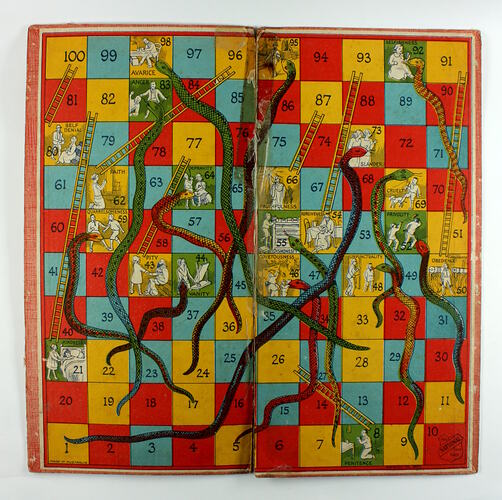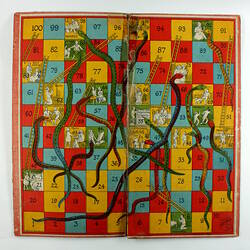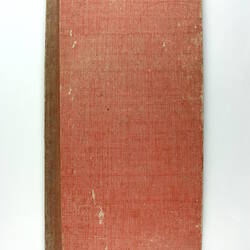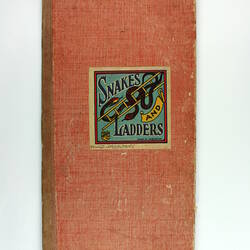Summary
Snakes and Ladders game made by National and used in Sydney, New South Wales and Burnie, Tasmania, circa 1940-1950.
The object of the game is to be the first to move from 1 to 100, avoiding the snakes which take you away from the end, and climbing the ladders which move you more quickly through the board. The game is a "moral" one: penitence, kindness, pity, faith, forgiveness, obedience, truthfulness and self-denial are at the base of ladders, while snakes emerge from unpunctuality, covetousness, vanity, quarrelsomeness, dishonesty, frivolity, cruelty, depravity, anger, selfishness, pride and avarice. The game looks to be a 20th century reproduction of an earlier game.
The game was acquired second hand or possibly inherited by the donor's family, a Protestant family, in Sydney, mid-1940s. It was played with by sisters Wendy and Jill Dabourne in Sydney, and also in Burnie, Tasmania, while they were in primary school. Wendy remembers that they used a single dice to play, and tokens such as round discs or buttons. The board eventually split down the middle, which Wendy repaired with tape. She later stored it away, and her own children did not play with it. Wendy donated the game to Museum Victoria in 1992.
Physical Description
Board game, Snakes and Ladders, on cardboard board backed by a red backing. The board consists of 100 coloured squares; It has been mended along the fold with cellotape. It is multi-coloured, in red, yellow blue, green and white.
Significance
The first large-scale manufacturer of locally designed board games in Australia was W. Owen of Ballarat who established business in 1877 as a wholesale tobacconist and fancy goods merchant. A few years later he opened a sports depot. By 1900 Owen's Sports Depot was producing board games under the 'National' label. Many remained current for over 25 years, sometimes with updated graphics. There is an advertisement for the 'National' board games in the trade journal 'Items of Interest' in 1912, showing a wide range available at 6 pence each. Owen appears to have had each game individually designed; many of the boards are evocative and pleasing graphics in their own right.
An artist, Christopher George King, from Hawthorn, Victoria, designed many of these games between 1902 and 1928.
More Information
-
Collecting Areas
-
Acquisition Information
Donation from Reverend Wendy Dabourne, 10 Feb 1992
-
Manufacturer
National Board Games, Australia
The 'National' board games were produced through Owen's Sports Depot (prop: W. Owen of Ballarat) from circa1900 to circa 1940. -
Place & Date Used
Sydney, Greater Sydney, New South Wales, Australia, 1940-1950
-
Place & Date Used
-
Inscriptions
Printed front of board: 'SNAKES/AND/LADDERS/MADE IN AUSTRALIA. Handwritten: W and J. DABOURNE.'.
-
Classification
-
Category
-
Discipline
-
Type of item
-
Overall Dimensions
18 cm (Length), 36 cm (Height)
-
References
Pers. comm, donor with curator Deborah Tout-Smith, 21 Jan 2018.
-
Keywords



